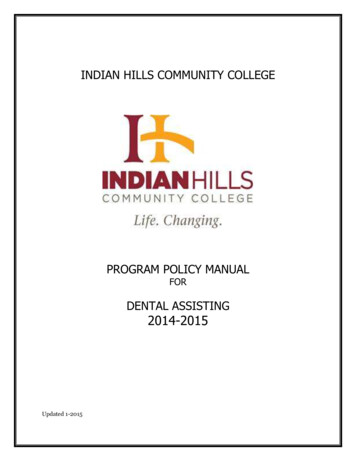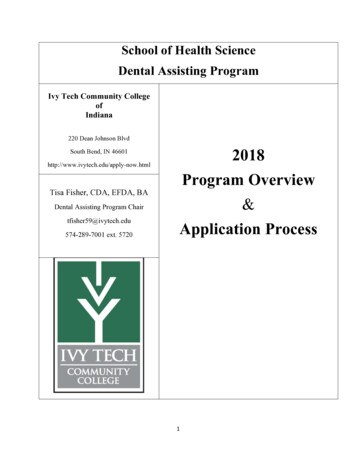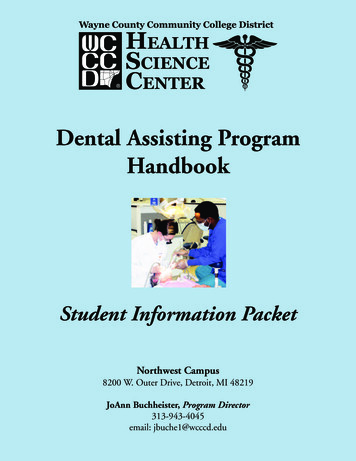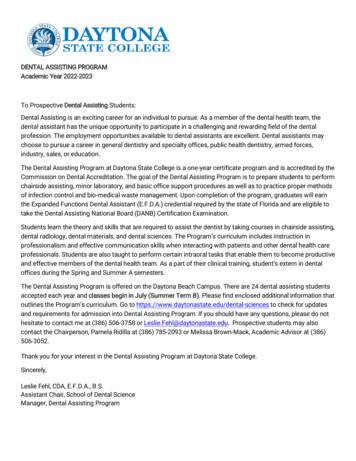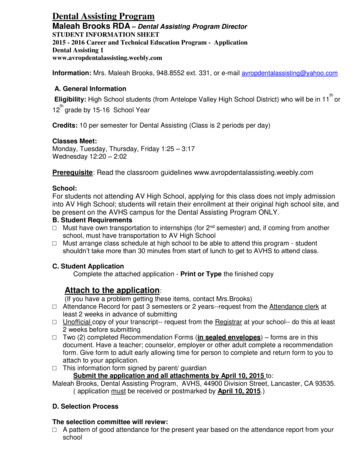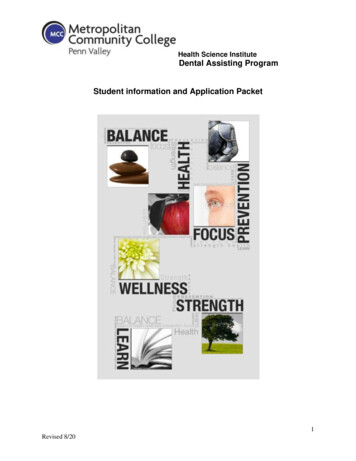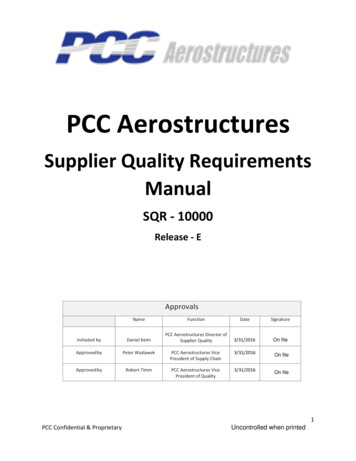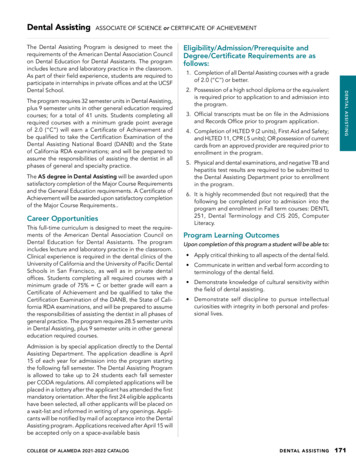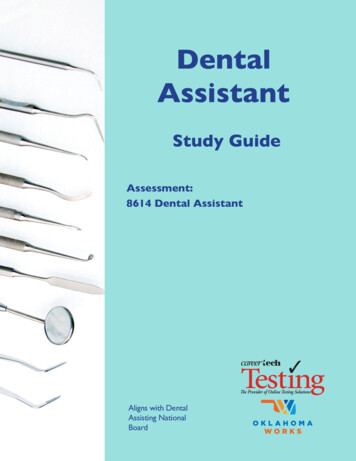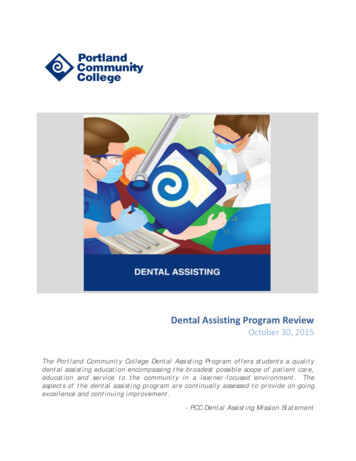
Transcription
Dental Assisting Program ReviewOctober 30, 2015The Portland Community College Dental Assisting Program offers students a qualitydental assisting education encompassing the broadest possible scope of patient care,education and service to the community in a learner-focused environment. Theaspects of the dental assisting program are continually assessed to provide on-goingexcellence and continuing improvement.- PCC Dental Assisting Mission Statement
Table of ContentsI.II.III.IV.V.VI.VII.VIII.Program Overview3a. Educational Goals/Objectives of Program3b. Changes made as result of SAC Recommendations5Outcomes and Assessment8a. Course-Level Outcomes8b. Core Outcomes10c. Certificate Outcomes12Other Curricular Issues17a. Courses offered in Distance Learning Modality17b. Curricular Changes/New initiatives18c. Dual Credit Courses20d. Use of Course Evaluations21e. Other Significant Curricular Changes Since Last Review21Needs of Students and the Community22a. Changes due to student populations served22b. Strategies to Facilitate Success/Disabilities25c. Feedback from Groups Used for Curricular Changes25Faculty27a. Reflect Diversity and Cultural Competency Goals27b. Changes Made to Instructor Qualifications27c. Faculty Professional Development Activities28Facilities and Academic Support30a. Classroom Space, Technology, Equipment30b. Library Usage30c. Student Use of College Resources31For CTE Programs32a. Advisory Committee Impact32b. Current and Projected Demand and Enrollment Patterns 32c. Student Selection Process33d. Job Placement Data34e. Completion Rates35f. Opportunities to Continue Education36Recommendations37a. Improvements for Teaching, Learning, Student Success37b. Support Needed from Administration40Appendices: 1. Program and Curriculum Management Plan2. End of Term Curriculum Review Form 3. DA Course of Study4. Technical Skills Standards 5. 2014/15 DA Externship Sites6. Advisory Committee Members 7. Advisory MinutesDental Assisting Program Review 2
I. Program OverviewPortland Community College’s Dental Assisting Program began in 1965 at the Failing HallBuilding by the Ross Island Bridge. Since its move in 1969 to the Sylvania Campus, manychanges have taken place within dentistry and specifically in the dental assistingprofession. What has stayed constant over the years is the quality education that each cohortof 45 students receive when enrolled in the nine month program. Proudly, the PCC DAprogram’s reputation is stellar within the dental community and our graduates are highlysought after.The program is fully accredited by the Commission on Dental Accreditation (CODA). In 2010, atits most recent self-study review and site-visit, the Commission report offered no suggestionsor recommendations to the program for improvement. The primary purpose of the self-studyprocess is to assess the effectiveness of the educational program in meeting 1) the program’sstated goals and objectives and 2) the Commission’s Accreditation Standards for DentalAssisting Education Programs. The next Accreditation Self-Study and Site-visit will take place inFebruary 2017. Providing information for the PCC Program Review will be of great value whendeveloping the report needed for Accreditation.A. What are the educational goals or objectives of this program/discipline? How do thesecompare with national or professional program/discipline trends or guidelines? Havethey changed since the last review, or are they expected to change in the next five years?The following program goals have been set by the faculty, director and staff to ensure thestudents’ educational needs are being met: Goal 1 Access - We will provide access to quality dental assisting education through theuse of scientific evidence based instruction and technology that meets current industrystandards. Goal 2 Student Success - We will promote success for all dental assisting studentsthrough outstanding teaching by faculty who act as mentors and professional rolemodels and who provide instructional methodology that prepares the student tosuccessfully complete national, regional and/or state examinations required forcertification and entry into the workforce. Goal 3 Diversity - We will enrich the dental assisting student’s educational experience byproviding and promoting cultural awareness that acknowledges each individual’s worthand uniqueness and enhances effective interactions, communications and/or provisionof care with all individuals or groups.Dental Assisting Program Review 3
Goal 4 Continuous Improvement - We will develop faculty and students whocontinuously seek to enhance knowledge as life-long learners by seeking peer support inprofessional associations, fulfilling evidence based continuing education and applyingself-assessment and reflection skills. Goal 5 Cultivating Partnerships - We will create partnerships that effectively linkstudents with practicing oral and other health care professionals who will provideadvising, mentoring and enrichment experiences in preparation for employment upongraduation. Goal 6 Community - We will serve as a key resource to the community bycomprehensively preparing competent students who assist and provide service duringtreatment of patients at the onsite PCC clinic or while participating in enrichmentexperiences in the community or during externship rotations. Goal 7 Ethics and Responsibility - We will prepare the student to practice ethically andresponsibly as a Certified Dental Assistant.The program goals have been designed to reflect the college’s core themes of Access andDiversity, Student Success, Quality Education, Economic Development andSustainability. Additionally, the theme of Ethics and Responsibility demonstrate theimportant governance of the Oregon State Board of Dentistry State Practice Act. OtherNational Guidelines that are followed include:The Commission on Dental Accreditation (CODA) Standards which state:“The program must demonstrate its effectiveness through a formal and ongoing planningand outcomes assessment process that is systematically documented and annuallyevaluated. This process must include the following: Dental assisting program goals that include, but are not limited to student outcomesthat are consistent with the goals of the sponsoring institution and appropriate to dentalassisting education; time-table for implementation that indicates roles and responsibilities of all participants; methods to assess goals and provide outcomes that include, but are not limited to,measures of student achievement; review and analysis of compiled data obtained from assessment methods, and relatedconclusions; findings and conclusions are used for program improvement, and for revisions to theoverall planning and outcomes assessment process.”- CODA Standard 1-1The Compendium of Curriculum Guidelines developed by the American Dental EducationAssociation (ADEA):Dental Assisting Program Review 4
“The guidelines are intended as a curriculum development aid. They are not official policystatements of ADEA; nor should they be construed as recommendations for restrictiverequirements or as a mechanism to standardize allied dental education programs. Whileaccreditation standards have moved to a competency based curriculum model andassessment of outcomes as a means to determine whether a program is achieving its goals,program directors have indicated there is a need for more specific guidelines .Theseguidelines are intended for entry-level educational programs, regardless of level (Certificate,AS or BS) or institutional setting (community college, university dental school or academichealth center).Graduate competencies that should be imbedded .include .but are notlimited to: Problem solvingCritical thinkingHealth and safety concerns/conceptsRegulatory concernsHealth promotionProfessionalismEthicsCultural diversitySelf-assessment skillsEvaluation of current scientific literatureInterpersonal communication skillsEvidence -based decision making- ADEA Compendium of Curriculum Guidelines, Feb. 2005The dental assisting program goals reflect and support the PCC Institution and the nationalaccreditation commission as well as the American Dental Education Association. They havenot changed since the previous 2010 program review, but will be reviewed and revised thisyear so that they more accurately represent the newly developed PCC Strategic Plan andthe Outcomes Revisions and College Mission Statement changes that will be takingplace. The revised program goals will be presented in the 2017 CODA Accreditation SelfStudy Document.B. Briefly describe changes that were made as a result of SAC recommendations and/oradministrative responses from the last program review:Many changes have occurred based on SAC recommendations and/or administrativeresponses following the 2010 DA Program Review. They are presented in the followingtable:Dental Assisting Program Review 5
SACRecommendationPurchase newdental radiologyfilm processorImplementelectronic patientrecords and digitalimagingAdd two additionalradiology roomswith digital imagingcapabilitiesSend DXTRManikins in on aregular basis forrepairIncrease dentaloperatory space/reconfigure labs/add 6-7 dental unitsin the clinic/ replacecabinetry andstudent chairs indental materials aseAction TakenA donation wasreceived from aprivate practice of aProcessor in faircondition. Theextra processor hasextended the life oforiginal one.Encouraged theElectronic patientprogram torecords and digitalparticipate in thesensors are2011 Bond planning currently beingmeetingsinstalledIncorporate intoDue to the programthe Bond planningremaining in itscurrent space, twonew rooms are notbeing added in theradiology labSupport throughDXTRs sent Formargin moneyRepair annuallyrevenue2 new DXTRspurchased.Bring these itemsforward to the 2011Bond planningmeetingsUnable to gainadditional clinicspace to addadditional clinicchairs, unable toreconfigure labspace or put in newcabinetryImplementationYearNot PurchasedSept. 2015Computers anddigital sensorswere purchasedAugust 2015(2) refurbished‘11(1) Newpurchase ‘12(1) refurbished‘14Summer 2015:New dentalunits werepurchased toreplace theexisting 23dental units.Computers andelectronicpatient chartingincluded.Operator chairsfrom old unitswere kept toreplace theprevious 40Dental Assisting Program Review 6
SACRecommendationAdministrativeResponseAction TakenPay for staff andfaculty training thatwill have to occurwhen electroniccharting and paperrecordsare implementedRecommendedmargin moneysupport thisBond dollarsSummer 2015Provide funding fordevelopment ofdental radiologyvideos or purchasealready developedvideos.Discuss thepossibility ofcompensatingDentists at a higherrate than Step 1 onthe salary tableRecommended useof margin money tosupport thisPurchased Rad.Dental Prof. Video.This needs to beaddressed throughFederation andHuman Resources.Until permanentsolution isachieved, work withDivision Dean andDOI on salaryplacementInstructor developed videos withCamtasia / UtubeDirector is startingnew dentists atstep 2 when hiringImplementationYearyear old stoolsin the dentalmaterials lab.Renovation inlab occurred toallow studentsto be seatedwith legs underthe counter.Two daytraining inAugust 2015occurred withthe front officestaff. Theinstructors willreceive trainingduring FallTerm.20112014/15New Dentisthires in 2011,2012, 2013,2014, 2015.Dental Assisting Program Review 7
II. Outcomes and Assessments:Reflect on learningoutcomes and assessment, teaching methodologies, and content in orderto improve the quality of teaching, learning, and student success.A. Course-Level Outcomes: The College has an expectation that course outcomes, as listedin the CCOG are both assessable and assessed, with the intent that SAC’s will collaborateto develop a shared vision for course-level learning outcomes.i. What is the SAC process for review of course outcomes in your CCOGs to ensure theyare assessable?The dental assisting program utilizes a comprehensive curriculum and program reviewprocess annually to assess all aspects of program goals, course outcomes and learningexperiences (See Appendix #1 for Curriculum and Program Management Plan [CPMP]).SAC members meet weekly to discuss programmatic topics. Once each month themeeting is devoted to issues specifically listed on the CPMP. For topics needing more indepth discussion, the SAC utilizes the October and April SAC Inservice days.Specifically, the process for review of course outcomes in the CCOGs to ensure they areassessable, is a three step process. During the current term the SAC reviews the CCOG’sand Syllabi for the upcoming term. It is important that both CCOG’s and Syllabi arereviewed at the same time in order to ensure that instructors are quoting the CourseDescriptions and Intended Outcomes accurately as approved by the CurriculumCommittee and stated in the CCOG’s. Any minor changes within the course are stated inthe Appendix for the course and a decision is made regarding major changes that needto be brought forward to the Curriculum Committee for the next year. Additionally, atthe end of each term each instructor completes the End of Term Report (See Appendix#2) and submits it to the Director. This report maps the course with the CertificateOutcomes and allows the instructor to reflect on teaching methods, what went wellwith the course that term, and intended changes for the next offering. Further, specificcourse activities are chosen each year to assess whether they meet the course intendedoutcome as well as the certificate outcome and college core outcome they are mappedto. The in depth study is presented in the annual Learning Assessment Council (LAC)Report. Findings from the LAC Reports have been instrumental in determiningimprovements needed either in learning activity design or teaching methodology inorder to improve student learning.This three-pronged approach allows for thorough assessment by the SAC to ensure thecourse description, intended outcomes and topics are appropriate for student learningprior to the term offered and then also assessed at the end of the term forimprovement of the course prior to its next offering. The in-depth LAC reporting allowsDental Assisting Program Review 8
for focus specifically on certain aspects of learning activities to ensure the outcomes arebeing met in an assessable and effective way. The process that is currently beingpracticed satisfies both the college assessment requirements as well as the nationalCODA accrediting requirements.ii. Identify and give examples of changes made in instruction to improve students’attainment of course outcomes, or outcomes of requisite course sequences that weremade as a result of assessment of student learning.Since the 2010 Dental Assisting Program Review, the program has incurred manychanges. Two long-time faculty members retired and Jill Lomax and Magda D’AngelisMorris were hired to teach the Clinical and Radiology/Basic Sciences Coursesrespectively. In the few short years of their joining the team, major changes in curriculahave occurred based on assessment information gained from the CPMP, the End ofTerm Review and the LAC Reports. The SAC has worked very hard to implement thechanges listed below: DA 140 (Integrated Basic Science) was divided into two courses (DA 140A IntegratedBasic Science I and 140B Integrated Basic Science II). The purpose of this change wasto allow students who had previously taken a college level A&P Course, waive (DA140B) which was a repeat of information that they had previously learned in theirA&P Course. DA (160) Pharmacology and DA 156 (Ethics) were inactivated so that a new courseDA 116 Introduction to Dental Assisting could be developed. This courseencompasses important introductory pharmacology and ethics/jurisprudenceinformation and is taught in the first term of the program rather than at the endwhere it had been previously taught. This change had been a long standing goal ofthe program, and one that has been of great benefit to students in their sequence oflearning. Dental Assisting students completed rotations to the OHSU School of Dentistry in thepast, but these rotations had been discontinued due to changes in philosophy byboth entities. For the 2015 school year both OHSU and PCC DA collaboratedtogether once again to reinstate the DA rotation experiences. The collaboration willbe discussed in greater detail throughout the report.Dental Assisting Program Review 9
B. Addressing College Core Outcomesi. Update the Core Outcomes Mapping Matrix - For each course, choose the appropriate Mapping Level Indicator (0-4) tomatch faculty expectations for the Core Outcomes for students who have successfully completed the course.Course #Course NameCO1CO2CO3CO4CO5CO6DA 110Clinical Procedures I022001DA 111Clinical Procedures I (lab)222122DA 112Clinical Procedures II033032DA 113Clinical Procedures II (lab)333233DA 114Clinical Procedures III204303DA 115Clinical Procedures III (lab)444444DA 116Introduction to Dental Assisting200202
DA 118Expanded Duties I333333DA 119Expanded Duties II443444DA 120Dental Radiology I222222DA 121Dental Radiology I (lab)222222DA 122Dental Radiology II333333DA 123Dental Radiology II (lab)333333DA 125Dental Radiology III (lab)444004DA 130Dental Materials I311102DA 131Dental Materials I (lab)310002DA 132Dental Materials II312103DA 133Dental Materials II (lab)322133DA 135Dental Materials III (lab)323144DA 140AIntegrated Basic Science I003002DA 140BIntegrated Basic Science II003002DA 142Integrated Basic Science III003003DA 150Dental Office Procedures I322112DA 152Dental Office Procedures II422123DA 9406Dental Assisting Practicum000000Course #Course NameCO1CO2CO3Dental Assisting Program Review 11CO4CO5CO6
C. For Career and Technical Educational Programs: Degree and Certificate Outcomesi. Briefly describe the evidence you have that students are meeting your Degreeand /or Certificate OutcomesSince 2010, with the help of Kendra Cawley (Dean of Academic Affairs) and SusanWilson (Academic Support Coordinator), the program has been able to assess thestudents’ ability to meet certificate outcomes in a much more streamlined process.Previously, the program was required by the institution to have certificate outcomesand the CODA Accrediting body required skill competencies. Kendra and Susan metwith the program director and SAC chair in 2013, and together, we were able todesign certificate outcomes that would meet both institutional and programaccrediting requirements. Additionally, it was determined at that time that theresults from national/regional testing could be used for Learning Assessment Reportanalysis. Their guidance was of great assistance to not only the DA program, butalso the DH and DT programs as well.The dental assisting certificate outcomes now encompass the core outcomes of theCollege and meet the skill competencies expected of the Commission on DentalAccreditation, and the State of Oregon Board of Dentistry’s standard of care for theprofession. Evidence that students are meeting the Dental Assisting CertificateOutcomes is listed below according to the course where the outcome is met and thedegree of competency that it is met at (Introductory, Developing or Competent).Also included are the certification exams taken by our students and the pass ratesince 2010:Please Note: For a complete list of Course Titles and Course Sequencing, SeeAppendix 3CertificateOutcomeApply theknowledgeand skillsrequired tosystematicallycollectdiagnosticdataMapped /sMeetThroughCompetencyLevelDA 110, 111,120, 121,150, rm,Final Exam,Lab/ClinicalSkillActivities,Self-Evals,Online CEIntroductoryDANB GeneralChairside (GC),Radiation Healthand Safety (RHS)ExamsDevelopmentalCertified DentalAssistant (CDA)(DANB),CompetentOregonRadiation140A, 140B,112, 113,118, 122,123, 132,133, 142DA 114, 115,119,, 125,135, 152NationalNtl. Certi.Certification Pass RateExam /StateCert.obtainedGC2014 84%2013 94%2012 91%2011 93%2010 93%RHS2014 94%2013 90%2012 85%2011 94%2010 97%
ProficiencyFunction asan effectiveand efficientmember ofthe dentalteam byperforming avariety ofclinicalsupportivetreatmentsUtilize themost currentinfectioncontrol andsafetyCommunicateeffectivelyboth verballyand in writingwith thedental teammembers andpatientsFunction in aresponsible,professionaland ethicalmannerDA 111ProfessionalCompetencyDA 120, 121,122, 123,133,DA 113, 118,115, 119,125, 135,152, 133DA 111Community warenessCommunity Assignments,Projects,Lab/ClinicalSkill Eval,Self-Evals,Final ExamJournalsDA 120, 121,122,DA 113, 118,123, 133,115, 119,125, 135,DA 111, 116,130, 131DA 120, 121,122, 123,132, 133,150,DA 113, 118,114, 115,135,119, 125, 152DA 110, 111,116, 130, 131DA 120, 121,140A, 140B,122, 123,132, 133,142, 150DA 112, 113,118, 114,115, nts,Projects,Lab/ClinicalSkill Eval,Self-Evals,Final ExamDANB GC.Infection Control(ICE), and RHSExamsOregonExpandedFunctions DentalAssistingCertificate(EFDA) andRadiationProficiency Cert.GC (seeabove %)ICE2014 88%2013 97%2012 89%2011 82%2010 86%RHS (seeabove %)IntroductoryDevelopmentalDANB ICE ExamICE (seeabove %)CompetentAssignments,Projects,Lab/ClinicalSkill Eval,Self-Evals,Final rojects,WrittenPaper,Quizzes,Midterm,Final talCompetentDental Assisting Program Review 13
Demonstratethe clinicalskills neededto performdirect patientcare as statedin Division 42in the OregonPractice ActAddress andrespondappropriatelyto the issuesthat mayarise fromcultural andsocioeconomic differencesin both adental andcommunityenvironmentDA olvingDA 120, 121,113, 118,122, 133,DA 123, 115,119, 125, 135DA 116, 120,121, 130CulturalAwareness140A, 140B,122, 123,132, 133,142, 150DA 113, 114,115, 125, 152Assignments,Projects,Lab/ClinicalSkill Eval,Self-Evals,Final ExamIntroductoryDANB CDA ties,WrittenPaper,Quizzes,Midterm,Final Exam,ServiceLearningProject,OnlineDiscussionDANB GC. ICE,and RHS ExamsOregon (EFDA)and RadiationProficiency Cert.GC (seeabove %)ICE (seeabove %)IntroductoryDevelopmentalNANACompetent(Results gathered from End of Term Reports)ii. Reflecting on the last five years of assessments, provide a brief summary of theoneor two of your best assessment projects, highlighting efforts made toimprove students’ attainment of your Degree and Certificate Outcomes.In reflecting on the past five years of assessments, one of the best assessmentprojects was submitted in the spring of the 2013-2014 school year. These reportsreceived an “Exemplarity Report Award” from the Learning Assessment Council andassessed the following program outcomes:Program OutcomeOutcome #1: Apply the knowledge and skillsrequired to systematically collect diagnosticdata.Outcome #3: Utilize the most currentinfection control and safety precautions inall laboratory clinical settings.PCC Core OutcomeCritical Thinking and Problem SolvingCommunity and EnvironmentalResponsibilityFor the Dental Assisting National Board (DANB), dental assisting students take 3external national exams throughout the dental assisting program. Although theexams are pass/fail, each exam has multiple sub-content categories that have beenmapped to the PCC core outcomes.Dental Assisting Program Review 14
While the desired level and benchmark for the Dental Assisting program is for eachstudent to successfully pass each of the three exams, it is possible for the studentsto still score lower than the state and/or national averages in certain sub-contentareas of the exam. If the dental assisting program can alter its curriculum tostrengthen the sub-content areas where the students scored lower than theaverage, it is likely that the overall exam scores of future students will be higher alltogether, thus increasing the pass rate.For outcome #1, the report found:49 students attained the desired level5 students did not attain the desired levelFor outcome #3, the report found:65 students attained the desired level8 students did not attain the desired levelEfforts were made to improve students’ attainment for degree outcomes thatincluded the following:1. Compare PCC scores to both national and state averages. In general, the DentalAssisting SAC found that PCC’s scores were slightly below the Oregon average,but either slightly or moderately above the national average.2. Identify the content in the weakest sub-content areas of the exam and makeacademic changes that strengthen the curriculum in that area.3. Perform formative assessments by creating mock board exams to monitorstudent attainment and prepare students for the national exams. Mock boardexams were conducted throughout the following (2014-2015) school year.For the full report, click on following iveEOY.htmliii. Do you have evidence that the changes made were effective (by having reassessedthe same outcome)? If so, please describe briefly.Reassessments for these outcomes have not yet occurred. Since DANB sends out theexam results once a year that covers the time period between Jan. 1st-Dec. 31st,results will be re-assessed in the spring of 2016 after getting the DANB report forJan1st-Dec. 31, 2015.iv.Evaluate your SAC’s assessment cycle processes. What have you learned toimprove your assessment practices and strategies?Dental Assisting Program Review 15
The Dental Assisting SAC’s cycle process includes reporting on two programoutcomes per year as noted on the multi-year plan. Discussions regarding theassessment cycle and reports take place in a face-to-face meeting and occasionallyover email.To improve assessment practices and strategies, the SAC has received peer reviewfeedback from previous reports and have learned how to create meaningfulassessments (i.e. creating proper rubrics that support specific analysis and interrater reliability; not “averaging away” meaningful data). In addition, the main writerfor the reports for the past two years has been a Peer Reviewer for the LearningAssessment Council allowing for insight in ways to improve assessment practices,strategies, and writing of reports. As stated previously, the DA SAC was awarded the“Exemplary Report Award” in 2013/2014. Most recently at the 2015 SAC ChairInservice it was once again announced that the DA SAC had earned the “ExemplaryReport Award”. Being given this award two years in a row validates the hard work ofthe DA SAC and acknowledges efforts that have taken place to listen to the past peerreviewers’ feedback and utilize it for improving student assessment and theevaluation of its success in DA student achievement of outcomes.v. Are any of the PCC’S Core Outcomes difficult to align and assess within yourprogram? If yes, please identify and explain.While all PCC’s Core Outcomes have been successfully mapped to the DentalAssisting Program Outcomes, Cultural Competency is more difficult to assess.Currently students receive the majority of their cultural competency training whileenrolled in DA 116, Introduction to Dental Assisting. This course includes the topicsof ethics in healthcare and dental radiology. Students learn how to address patientsof different cultures (particularly the Latino and Asian cultures) and how to identifycultural issues as it comes to accepting or not accepting suggested care. For thiscoming year the SAC is very excited to add to this course the “30 Minute SpeedTalking” offered by the International Students Department. It is hoped thatinternational students will come to the DA 116 course and discuss with the class thetopic of Oral Health within Their Culture. Rotating in a “speed dating” type formatwill allow students to exchange thoughts and ideas between cultures and willultimately be of great benefit to both groups of students. This collaborative event isscheduled to take place Dec. 1st, 2015.Please Note: The following table provides a brief review of the outcomes assessed forthe LAC Reports by the DA program since the last program review:Dental Assisting Program Review 16
YearOutcomeAssessed2014/15ProfessionalDANB National BoardIncrease instructionCompetenceTesting: General Chair-side in sub contentExam Scores and Radiationareas where lowCritical Thinking &Problem SolvingHealth and Safety Scores.scores received.Refer to Detailed Summary Above in Section ii of reportProfessionalDA 123 Radiology Lab Mock Add more mockCompetenceBoard Examboards and timedexercises intoearlier terms; Addflowcharts to helporganize vityChange madebased on findingsCommunicationService Learning Project/Presentation(DA112, 114)Self-ReflectionExternship Journal Reflections weeks 3, 6, 9Community andEnvironmentalResponsibilityDocumentation of MedEmerg and Haz WasteProtocols in Extern OfficesInclude info onpermission forphotographs.Improveinstructions andrubricImproved Rubric toinclude morecritical thinkingIII. Other Curricular IssuesA. Which of your courses are offered in a Distance Learning modality (online, hybrid,interactive television, etc.), and what is the proportion of on-campus and online? Forcourses offered both via DL and on-campus, are there differences in student success?If so, how are you addressing or how will you address these differences? Whatsignificant revelations, concerns, or questions arise in the area of DL delivery?All program classes have a level of distance learning modality ranging from completeonline (DA 130) to using D2L for providing quizzes and recorded l
Dental Assisting Program Review 3 I. Program Overview Portland Community College's Dental Assisting Program began in 1965 at the Failing Hall Building by the Ross Island Bridge. Since its move in 1969 to the Sylvania Campus, many changes have taken place within dentistry and specifically in the dental assisting profession.
